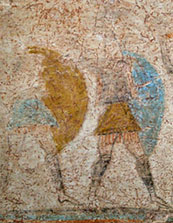 |
The Greek Age of Bronze
Round Shields |
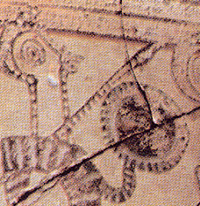 |
| The utilization of small, medium and large size round shields it seems to be attested in the Aegean area only starting from LH IIIB (about 1300 BC). The archaeological evidences show how this defensive element was largely used during the last periods of the Late Helladic. Being mostly of these shields made of hide or other perishable material no complete specimens have been so far discovered in the Aegean area except for bronze bosses or reinforcements. Indeed because well preserved round bronze shields have been found in central and north Europe the utilization of similar shields is considered fully reasonable also in the Achaean world.
|
| This round object with a diameter of about 50 cm dated about 2000 BC found by Henry Schliemann during his Troy excavation on Hissarlik hill has been interpreted as a copper shield with rim and central boss. Even if for some scholars this interpretation is questionable it is worth to be mentioned as a possible evidence of round shields utilization by the early Anatolian/Aegean populations. |
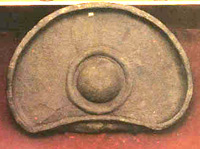 |
 |
One of the simbols of the still undeciphered Phaistos disk dated 2000-1700 BC has been also interpreted as an embossed round shield. |
| Some of the gold plaques, buttons and terra-cotta ornaments from the royal shaft-graves of Mycenae dated around LH II (about 1500 BC) have been interpreted by Henry Schliemann as miniature copies of shields. Of course this interpretation is fully questionable being neither supported by artistic representation nor by findings |
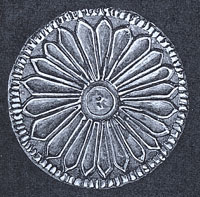 |
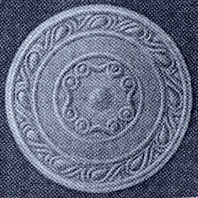 |
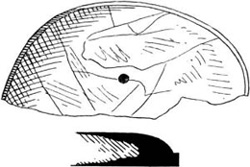 |
Indeed a large wooden object (which has been pieced together out of many fragments) found in the grave V of Mycenae dated around 1500 BC, is of great importance. It is almost certainly a portion of a shield. Its flat face is curved to meet the rim, which is formed by a projecting narrow horizontal border of neat workmanship. It seems probable, therefore, that we have here one end of a large round shield pinched in the middle. In the centre of the preserved portion is a round hole, which served to fasten either a handle/baldric on the inside or a large device on the outside.
|
| A human figure handling a round shield seems inscribed in this roundel from Khania Crete dated around LM IB (about 1450 BC) |
 |
 |
The earliest possible evidence of round shield is from a fresco fragment representing hunting scenes from Pylos dated around LH IIIB (about 1300 BC).
In the interpretative reconstruction made by the archaeologist Piet de Jong this medium size shield seems equipped with a lateral hand grip, a central arm sling (*1) and a reinforced rim around the edge. |
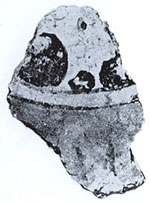 |
From the same decorative phase is another fresco fragment from Pylos where a possible round shield made of ox-hide with reinforced edge is partially preserved. Round shields made of several layers of hide are also attested in the Iliad (*2) |
| Two warriors with small round shield are well represented in a large krater from Tiryns dated LH IIIB2 (around 1250 BC). These shields seem decorated with several bosses on the rim and in the central area of the shield. Because the similarity with some bronze shields attested in central and north Europe the possibility that the shields represented in this krater were made or reinforced with decorated/embossed bronze sheet can't be excluded.
|
 |
 |
From a very interesting krater fragments found in Voudeni near Patras dated around 1200-1100 BC two warriors on a four wheels chariot are equipped with medium size round shields. |
A medium size round shield is also represented in this other krater fragment from Thermon dated around the second half of 11th Century BC. (drawing by Diana Wardle)
The decoration of this shield could be similar to the one attested in some bronze specimens coming from the central/north Europe (see also the central/north Europe shields dedicated section)
|
 |
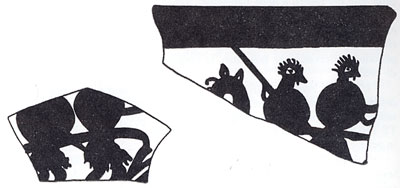 |
In a couple of krater fragments from Mycenae dated LH IIIC some warriors on chariots are equipped with medium size round shields which are probably beared on warrior's back by means of a baldric "Telamon". |
| Other examples of round shields carried on back are represented in these two ivory mirror handles dated 12th Century BC respectively from Kouklia and Enkomi Cyprus. In these relief the internal part of the shields shows a decorated or embossed rim. |
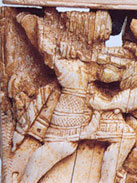 |
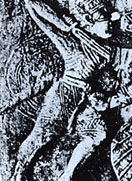 |
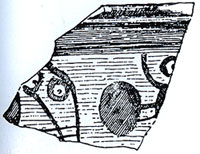 |
A medium size round shield is also represented in this pottery fragment from Tiryns dated LH IIIC. |
| In another krater fragment from Tiryns dated LH IIIC two warriors in chariot carryng small round shield and two javelins or light spears are depicted. |
 |
 |
In this other famous pottery fragment from Tiryns dated LH IIIC a medium size decorated round shield is beared by the warrior on the left side. |
| In these krater fragments from Lefkandi dated LH IIIC two helmeted warriors seem to be equipped with medium size round or oval shields. |
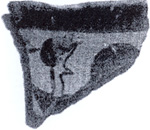 |
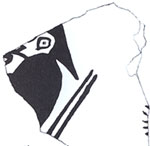 |
 |
A medium size round shield is depicted in this krater dated LH IIIC representing a naval battle. The second warrior from the left is bearing a square fringed shield (see also the page dedicated to the other shields) |
| In this other naval battle scene depicted on a krater from Bademgedigi Tepe in the west Anataolia dated LH IIIC the warriors are equipped with small round shields and "edgehog" style helmets (see also the page dedicated to the late helmets). |
|  |
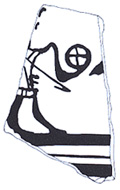 |
A standing warrior holding a small size round shield is depicted in this krater fragment from Kynos dated LH IIIC. The shield is more likely seen from the inside. |
| Lateral representation of possible round shields are from these pottery fragments dated LH IIIC respectively from Kynos and Kos. |
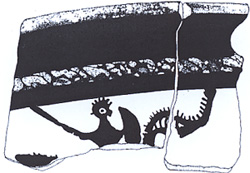 |
 |
 |
A very interesting variant of round shield is the one represented in the warriors vase from Mycenae dated LH IIIC. In the side A of this krater six warriors equipped with medium size round shields with a large cut are represented. The internal area of the shields with a ridged rim is visible, it could be interpreted both as the hide's fold edge or as bronze bosses for edge reinforcement. |
| In the side B of the same krater five warriors are equipped with large round shields. Also in this case the internal area of the shields shows a ridged rim which could be interpreted both as the hide fold edge or a bronze bosses for edge reinforcement. In the left shield the hand grip is also clearly represented. |
|  |
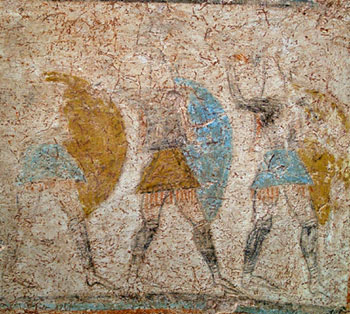 |
Similar large round shields are also represented in the colourful stele from Mycenae dated in the same period of the warrior vase. These painting attested how some of the shields were more likely painted even in the internal side. |
|
| A large circular or oval shield is well represented in this domed seal from Enkomi Cyprus dated around 1190-1180 BC. The motif on shield's external surface have been interpreted as the wickers structure of the shield. Indeed because a big central boss seems also be present we can't exclude that the external surface of the shield was made of a metal sheet with relief decorations (see also the page dedicated to the Iliad shields)
|
 |
 |
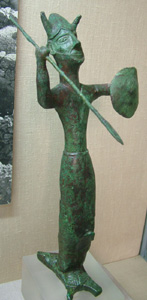 |
For what concern the bronze statuettes two representation of warriors with small round shields are respectively from Delos dated LH IIIA-B (about 1350 BC) and Enkomi dated about 1200 BC. The statuettes show a mix of Aegean and Oriental elements like for instance the curved sword (*3) represented in the statuette on the left which even if known also in Greece mainland it represent an oriental style Bronze Age weapon. |
|
| From sanctuary of Syme Viannou, Crete there was a LM IIIC (Late) figurine of a nude armed male. He wears a helmet and carries a spear and a small round shield.
|
 |
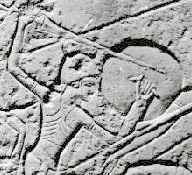 |
large and medium circular shields in some cases also embossed are beared by the "Sea People" as represented in some Egyptian Relief (see also the page dedicated to the Sea People)
|
| As also explained in the page dedicated to the body-shields a possible "proto-Dipylon" variant of medium or large size circular shields are attested in two pendants respectively from Eutresis Beotia and from a greave in Athens both dated LH IIIC (actually two similar pendants in shape of proto-Dipylon shields have been found in Athens).The utilization of round shields is attested also in Crete being some clay models found in several location as Psirà, Phaistos and Mulianà.
|
 |
 |
| For what concern the metal findings several bronze bosses have been discovered in Greece mainland and Aegean area. The older specimen is a bronze boss from Middle Cypriot III (about 1750-1600). But of course the round boss does not necessarily prove a round shield. |
|
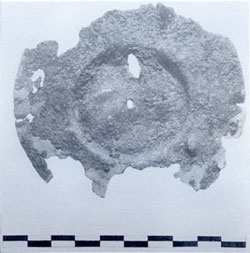 |
A small fragmentary circular bossed plate dated at the end of LH IIIC is from Achladies-Achouria or Chadzi-Trapeza. It consists of a flat round disc, of about 96 mm in diameter whose centre had once been raised to form a hemispherical boss of about 43 mm in diameter. The boss is pierced by a single hole at its centre. There is no rivet, or stitch holes, and no visible impressed ornament. This example closely resemble those found in Cyprus at Pyla-Kokkinokremos dated 1200-1100 BC and in the Kaloriziki Tomb, which are dated at the very threshold of the iron Age (see the page dedicated to the other shields). |
|
| A interesting Achaean bronze shield's boss large about 100 mm dated around 1200 BC it has been also found during an excavation near Sparta.
|
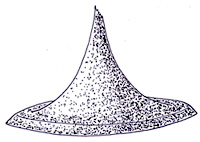 |
 |
The two specimens from Pyla-Kokkinokremos Cyprus dated 1200-1100 BC are very similar to the above mentioned example and are very well preseved. These bosses have a diameter of 88 mm and a single hole at their centre as well. |
|
| From Mouliana are these two beautiful example of bronze shield bosses dated from XIII to XI century BC. Both the specimens are about 190 mm in diameter and show decoration bossed dots around the edge.
|
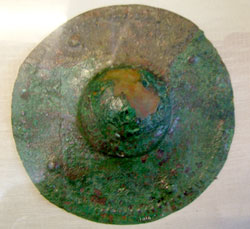 |
 |
 |
 |
The circular bronze plates found in a late Achaens grave in Liatovouni Hill (see also the page dedicated to the corselet) dated 13th-12th Century BC can be also interpreted as shield's bosses (*5).
These "omphalia" cold have been parts of a large shield or belong to different medium size shields. |
|
| Shields reinforced with several bosses are also beared by the Sea People as attested in the relief at Medinet Habu (see also the page dedicated to the Sea People)
|
 |
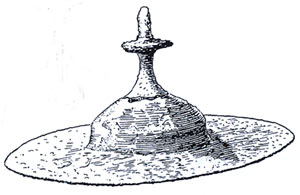 |
In the sub-Mycenaean tomb XXVIII in Tiryns dated about 1060 BC a bronze shield boss large 105 mm in diameter with elongate central element 50 mm high has been found. This boss has been found together some weapons and a decorated bronze helmet (see also the page dedicated to the late helmets) |
|
| Similar bronze shield boss dated around 1050 BC has been also found in the Kerameikos of Athens. The dimension of this boss are 340 mm in height and 174 cm in diameter
|
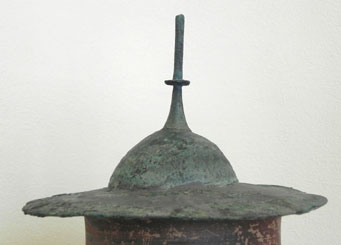 |
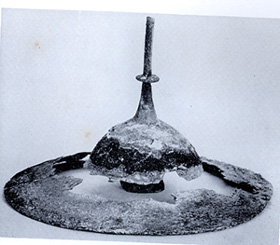 |
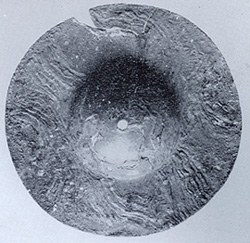 |
Also from Kerameikos of Athens is this boss dated from the same period. it measure 114 mm in diameter |
|
| Similar well preseved bronze shield boss dated around the X century BC has been also found in Crete. Bronze shield bosses are attested in several settlements (Pherai, Philia, Olympia, Patras) dated from the sub-mycenaean through the geometric period. |
| 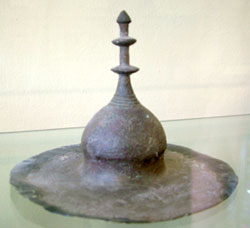 |
 |
Another Early Iron Age bronze shield boss from a grave in Karagiorgos dated around 1000 BC |
|
Three well preserved shield bosses have been found in the grave 40 in Kalorisiki in Cyprus dated around 11th Century BC.
These bosses have been found together other bronze plates which have been wrongly reconstructed as reinforced parts of a trapezoidal shield. The bronze plates are actually identified as part of a conical helmet (see the page dedicated to the late helmets) thus the actual shape of the shield equipped with these three bosses is unknown. |
| 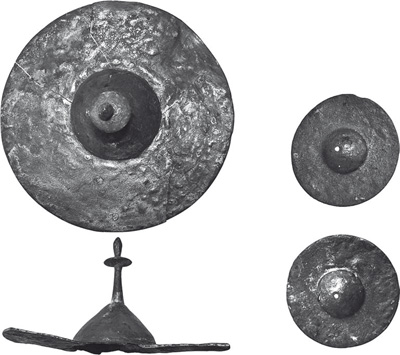 |
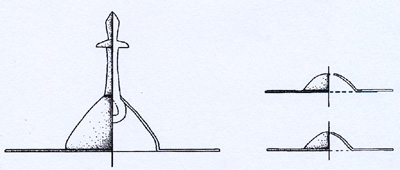 |
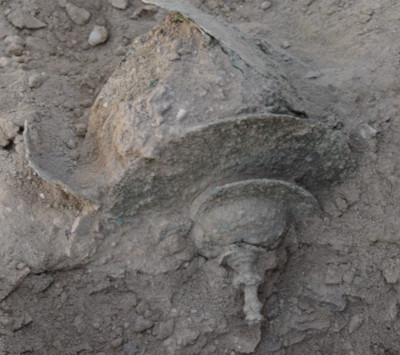 |
Similar bronze shield boss was found in Phaistos (Crete). These element together with a two cheek guars and perhaps a part of a belt were contained inside a large pithos in an cult dated around the 7th-8th century BC although the elements may have belonged to a "local hero" of the XII-XI century BC whose cult was still celebrated during the archaic period |
|
| CENTRAL/NORTH EUROPE SHIELDS
|
Some of the finest example of Central and North European Bronze Age defensive weaponry are found in the shields belong to the so-called Urnfield period (about 1300-700 BC). Because they fall to the same time period as the Greek Bronze Age civilization and because the commercial trade between the Achaean mainland and the Central Europe worthy to be mentioned are some of these European embossed shields.
Mostly of these shields would have made from either leather or wood, in some cases an external bronze embossed plate was also present. There are example dated at the beginning of the Urnfield period (about 1300-1200 BC) from Wollmesheim and Mehrstetten in Germany unfortunatelly now only evident through the metal studs they originally featured. On the Wollmesheim shield fragments of the wood still remained around the stud, enough to indicate an original thickness of about 20 mm. The Mehrstetten shield was large about 80 cm in diameter.
Several so-called "U-notch" (because of the U-sahaped notch within the circular stengthening ribs present on the face of the shields) have been recovered from Central Europe. Two were found in Ostprignitz Germany and were similar in design to the Danish shield from Taarup Mose. The following images show example of bronze shields attested in Danish. |
|
| The Pilsen-jikalka shield from Bohemia dated the first Urnfield period is another member of the U-notch group. Though in this case the notch is more crescent-shaped it measured in diameter about 50 cm. |
|
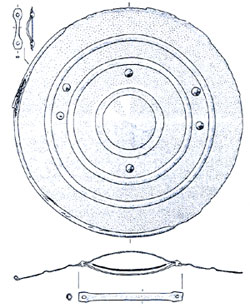 |
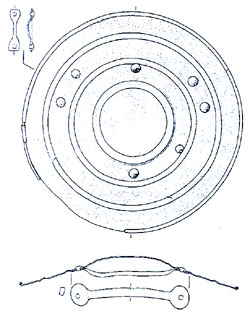 |
Another group of shields belong to the Nipperwiese class. These have two annular strengthening ribs without a notch, and have a handle rivetted at the back. Specimens have been found at Spalt in Bavaria, Mainz and Bingen in Germany, alongside the type-site of Nipperwiese itself (now called Ognics) in Poland. |
|
| Based on the elements found in the Nyirtura settlement, North east of Hungary, and in some other Centarl European Bronze and early Iron Age tombs it has been possible to reconstruct the general design of a typic embossed shield large about 60 cm in diameter. |
| 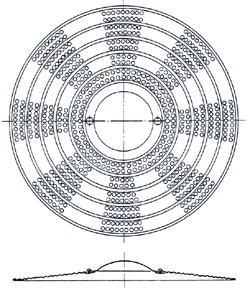 |
 |
A very beautiful bronze embossed and decorated shield dated around 1000 BC have been also found in Austria . |
|
| In the same area in Austria has been also found this other interesting embossed bronze shield also dated around 1000 BC. |
| 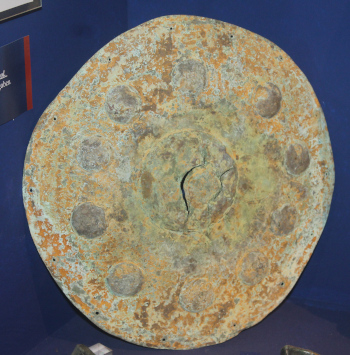 |
| CONCLUSION
|
The utilization of round shields is attested in the Aegean area only from the LH IIIB (about 1300 BC). Of course the lack of undubful evidences during the early stage of Late Helladic period do not necesarily means that the round shields were unknow in the Aegean area before the 1300 BC. In the final periods of Late Helladic several type of round shields were utilized as attested in several pottery paintings, fresco, sculptures and statuettes. As for the body-shields also the small, medium and large round shields were more likelly made of ox-hide and other perishable material like wickers or wood (*4). As attested in several finding in Greece mainland and Aegean islands some shields were also reinforced with bronze bosses and they were equipped with singol or double handle and "Telamon".
Even if no complete metallic shields have been so far recovered from the Bronze Age Aegean settlements, the utilization of round shields reinforced with large decorated bronze plate can't be excluded being several examples found in the Central/North Europe areas dated in a period compatible with the commercial trade between the Achaeans world and the nearest European populations.
|
(*5) SNODGRASS, A. M., "Bronze Phalara-A review", Hamburger Beitraege zur Archaeologie 3 : 41-50 (1973).
|
|